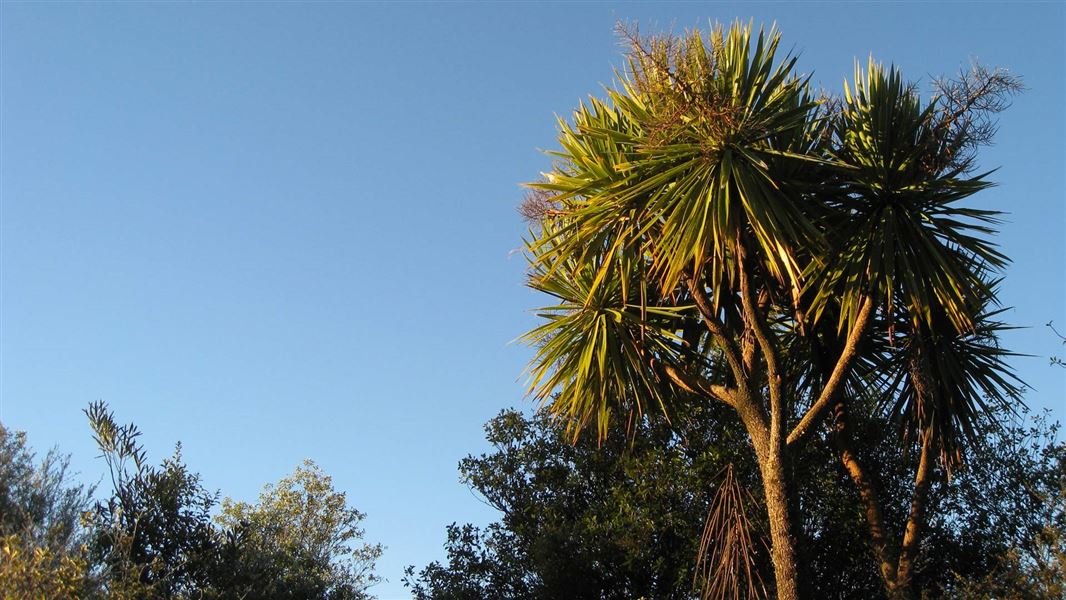Growing 12 to 20 metres high, cabbage trees (Cordyline australis) have long narrow leaves that may be up to a metre long. It has lovely scented flowers in early summer, which turn into bluish-white berries that birds love to eat.
As the plant gets old, the stems may die but new shoots grow from any part of the trunk. The bark is thick and tough like cork, and a huge fleshy taproot anchors the tree firmly into the ground.
Quick facts
- The trunk of the cabbage tree is so fire-resistant that early European settlers used it to make chimneys for their huts. Conveniently, too, the leaves made fine kindling. They also brewed beer from the root.
- Cabbage trees are one of the most widely cultivated New Zealand natives and are very popular in Europe, Britain and the U.S. In the U.K. they are known as Torquay palm.
- Cabbage trees are good colonising species, growing happily on bare ground or exposed places.
- Their strong root system helps stop soil erosion on steep slopes and because they tolerate wet soil, they are a useful species for planting along stream banks.
- Māori used cabbage trees as a food, fibre and medicine. The root, stem and top are all edible, a good source of starch and sugar. The fibre is separated by long cooking or by breaking up before cooking.
- The leaves were woven into baskets, sandals, rope, rain capes and other items and were also made into tea to cure diarrhoea and dysentery.
- Cabbage trees were also planted to mark trails, boundaries, urupā (cemeteries) and births, since they are generally long-lived.
Where is it found?
The cabbage tree/tī kōuka is common throughout farmland, open places, wetlands and scrubland of the North and South Islands, but are rare on Stewart Island.
Cabbage tree/tī kōuka grows up to 1000 metres above sea level in anything from wet swampy ground to dry windy hill slopes. The species prefers full sunlight, so it is common on farms and generally uncommon in tracts of continuous forest (although it is common on forest margins).
Other species
Aside from tī kōuka, there are four other species found in New Zealand. These are:
-
Cordyline obtecta – which in New Zealand is only known from the Three Kings, Murimotu and Poor Knights Island groups as well as a small area of North Cape. Until recently this species was known as C. kaspar but recent taxonomic opinion is that it is the same species as the earlier named Norfolk Island C. obtecta.
-
C. indivisa – the mountain cabbage tree or tōi, which is known from Great Barrier Island south to Stewart Island. This is a spectacular forest to high montane dwelling species with rather broad, bluegrey leaves.
-
C. banksii – the forest cabbage tree or tī ngahere. Found throughout the North Island and South Island to north Cantebury in the east and Haast in the west (with unconfirmed reports of it along the northern coastal portion of Fiordland). This species is typical of coastal to lowland forest but can extend into montane forest where it occasionally forms hybrids with C. indivisa. It is also worth noting that C. banksii readily hybridises with C. australis and C. pumilio.
-
C. pumilio – the so called stemless cabbage tree/tī rauriki, usually lacks a trunk and is often found in kauri forest or associated gum land scrub. When it is not in flower it is often mistaken for blueberry (Dianella nigra). C. pumilio readily hybridises with C. banksii forming plants known as C. x matthewsii.
Did you know?
In 1987, a mystery disease started to kill off cabbage trees in the North Island. It was not known what caused the disease, which was called ‘sudden decline’, and hypotheses for its cause included tree aging, fungi, viruses, and environmental factors such as enhanced UV.
After nearly five years of work, scientists found the cause was a parasitic organism called a phytoplasma, which they think might be spread from tree to tree by a tiny sap-sucking insect, the introduced passion vine hopper. The phytoplasma is native to New Zealand flax, and early last century caused massive epidemics of yellow leaf disease in flax, destroying the once extensive flax swamps of Manawatu and contributing to the eventual collapse of the once flourishing flax fibre industry.
Threats
Although widespread and abundant, cabbage tree populations have been decimated in some parts of New Zealand due to sudden decline. In some areas, particularly in the north, no big trees are left. Plants stricken with this illness suddenly and rapidly wilt, with leaves falling off still green. Infected trees usually die within 3 to 12 months. The good news is that although sudden decline often affects cabbage trees in farmland and open areas, trees in natural forest patches continue to do well.
You can help
There is still no cure for sudden decline, so we need to keep planting more young cabbage trees to replace the dying populations. Planting cabbage trees in gardens and land restoration projects will play an important role in maintaining cabbage trees in New Zealand.
Cabbage trees on farmland may be survivors of forest clearance in the nineteenth century (they are very difficult to kill), and they may be a dying breed unless they are fenced off from grazing stock. Fencing will also allow natural regeneration to occur.
